
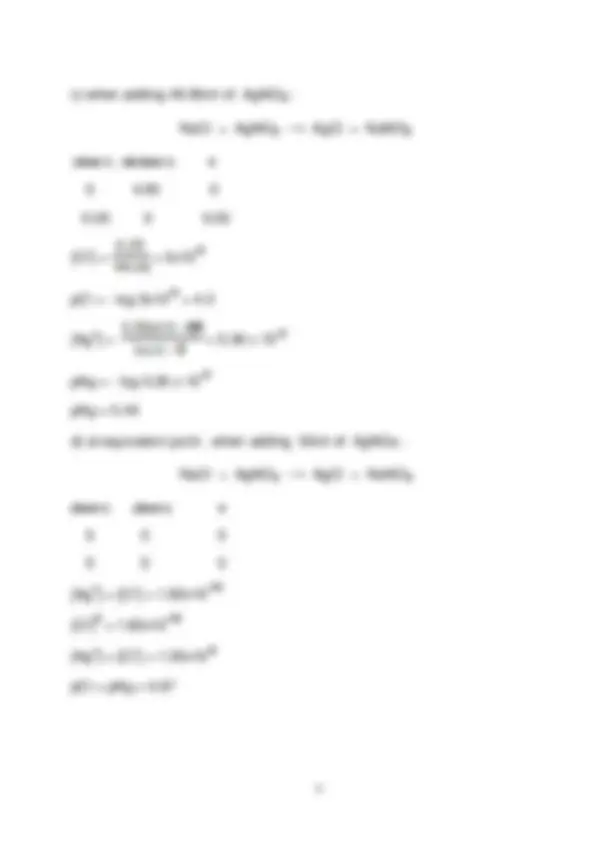
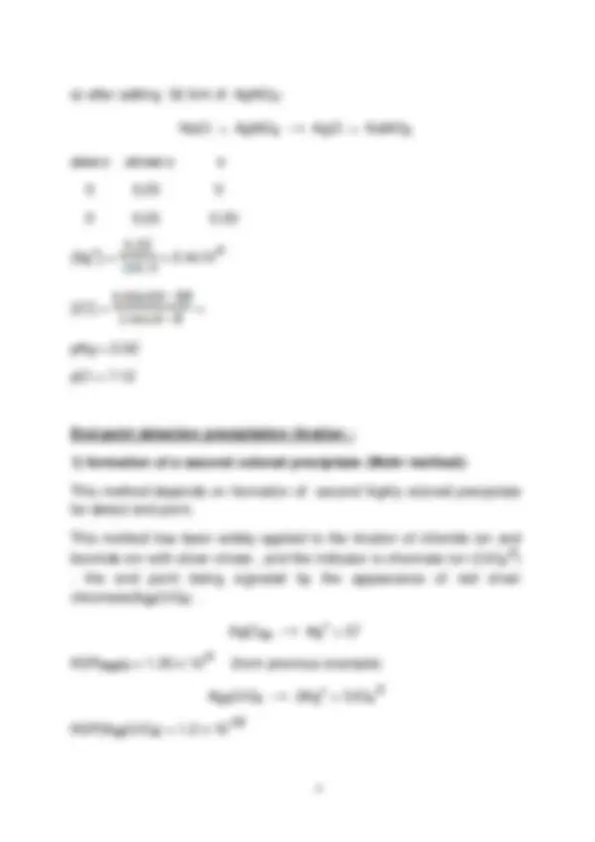
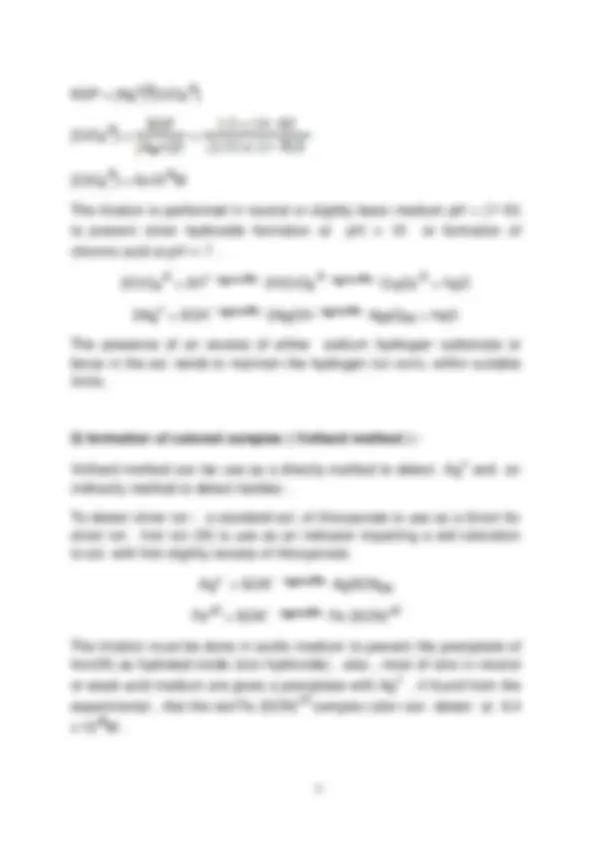
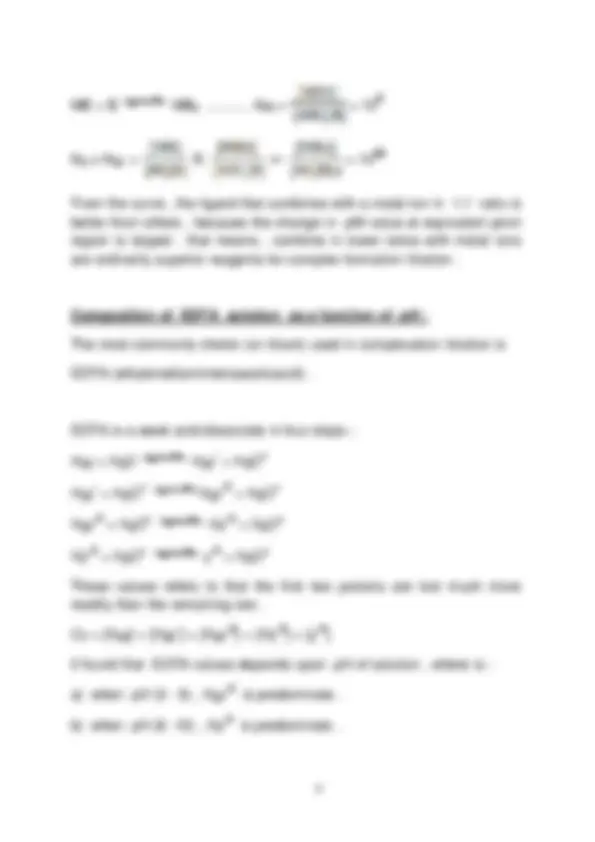
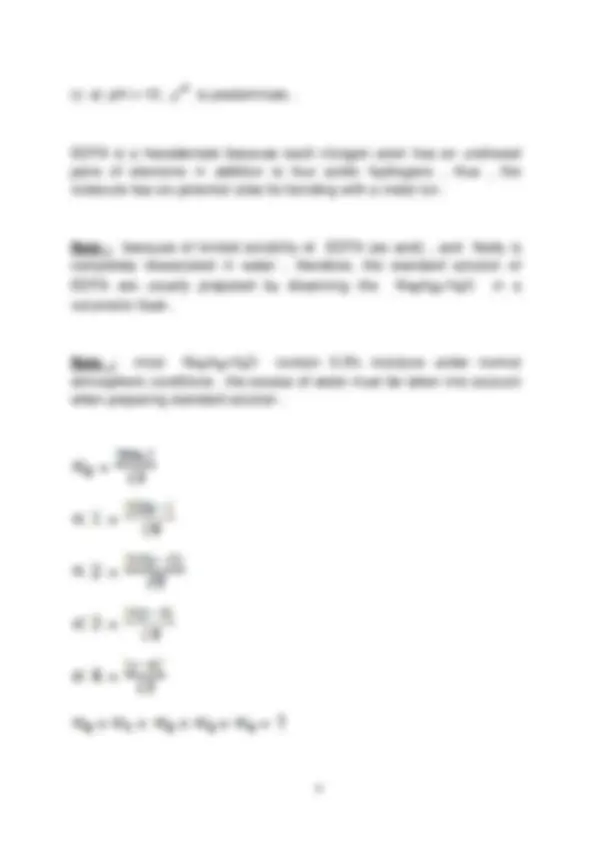
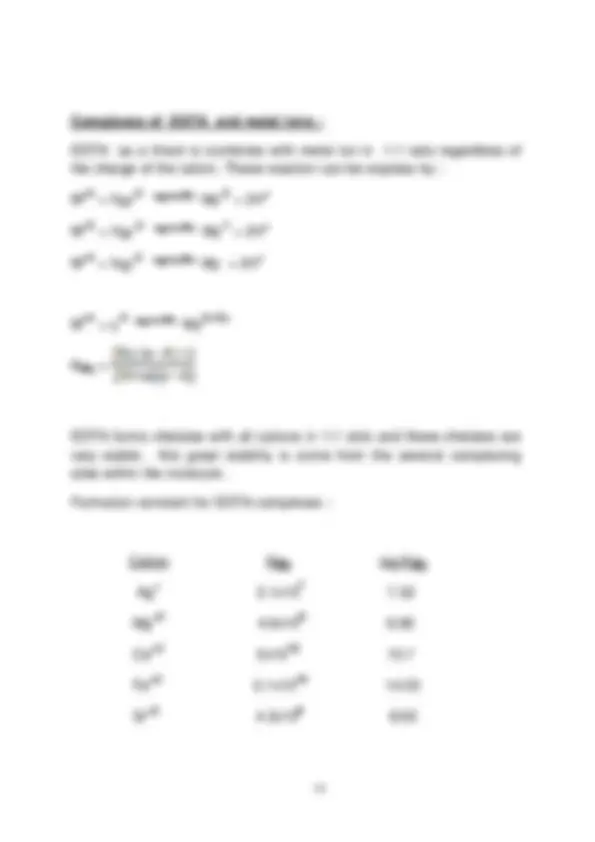
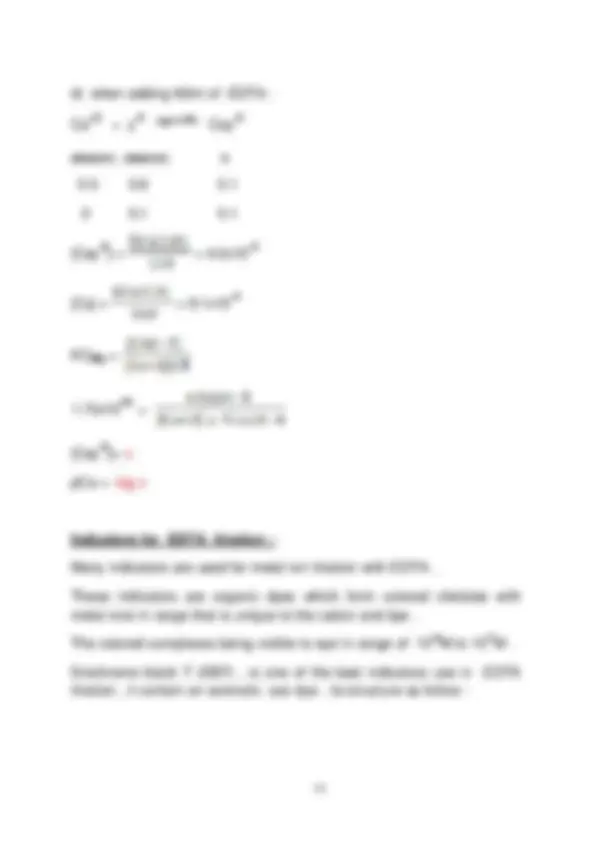
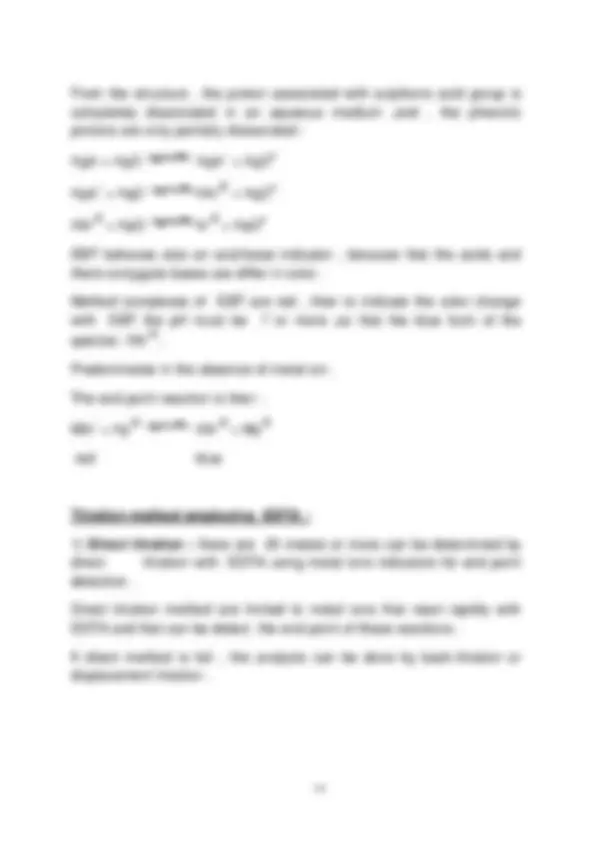
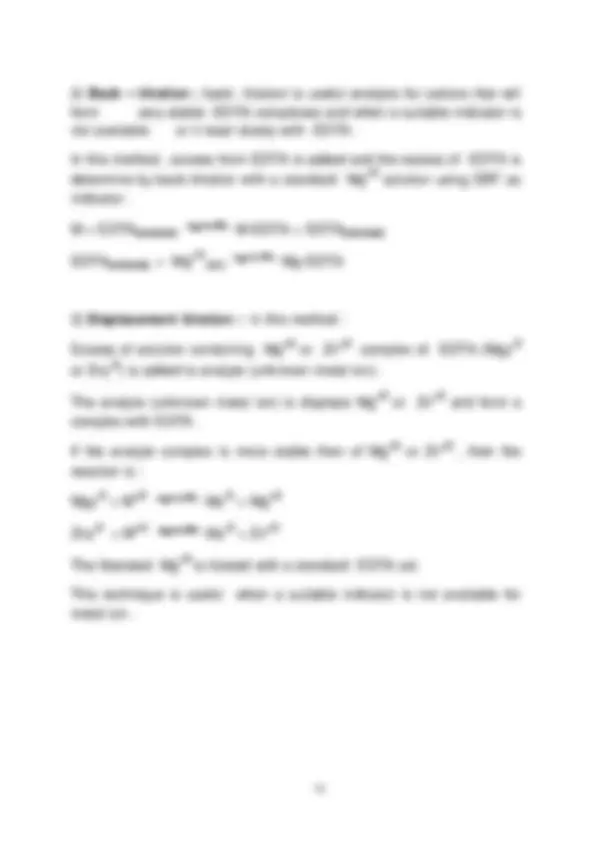
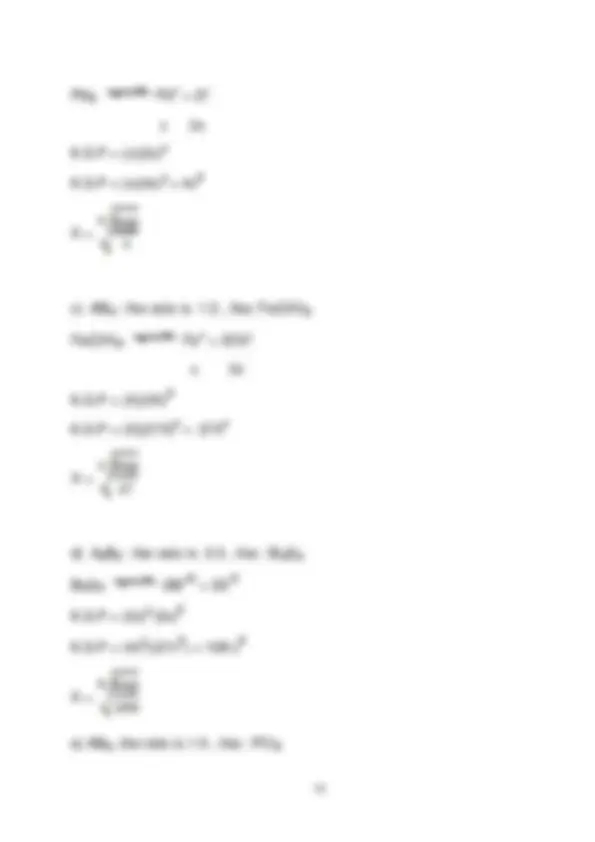

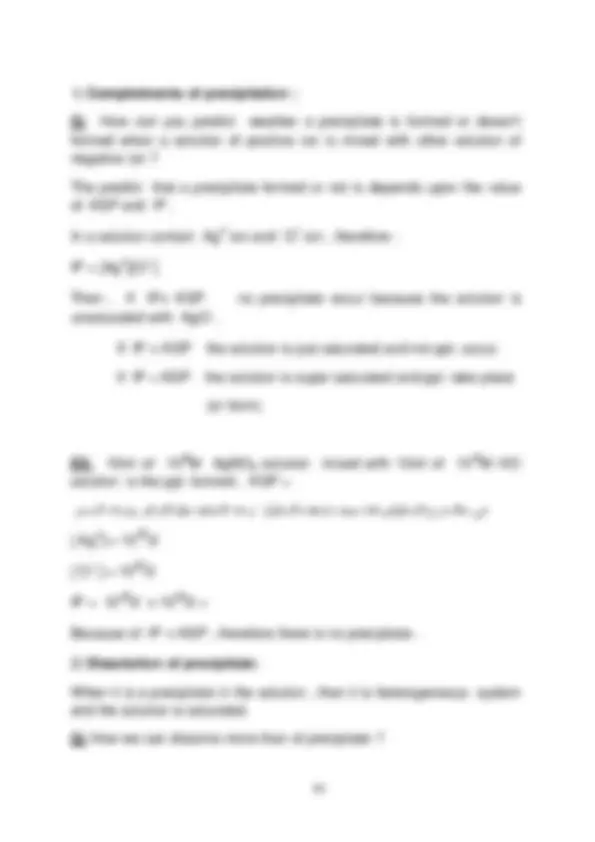
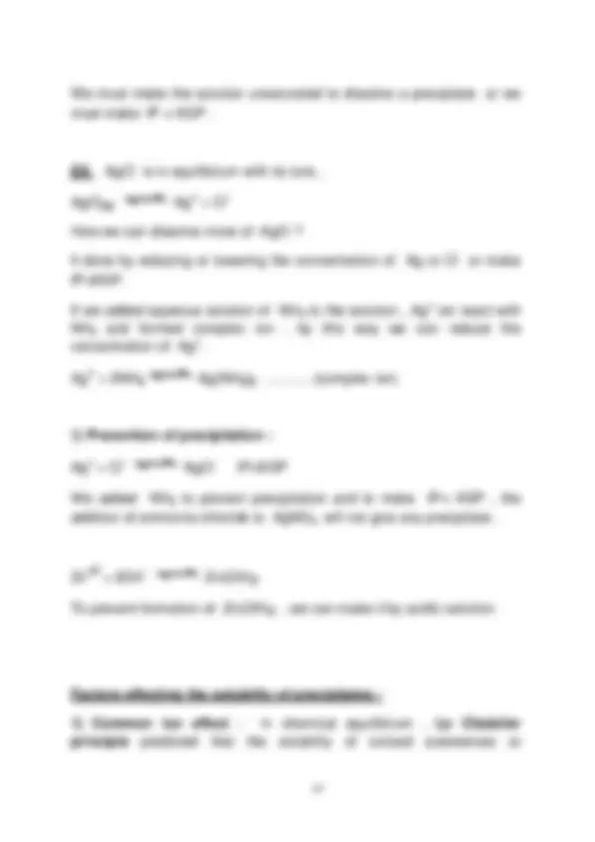
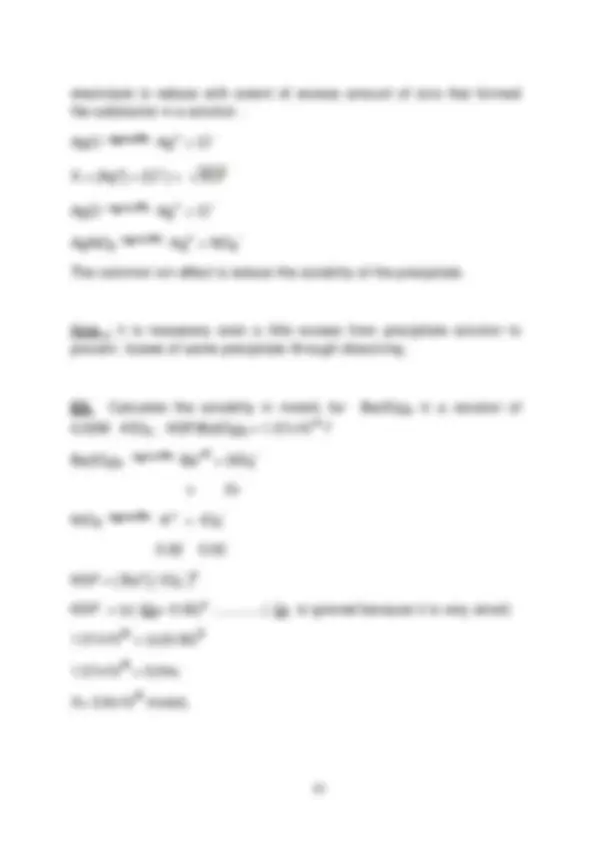
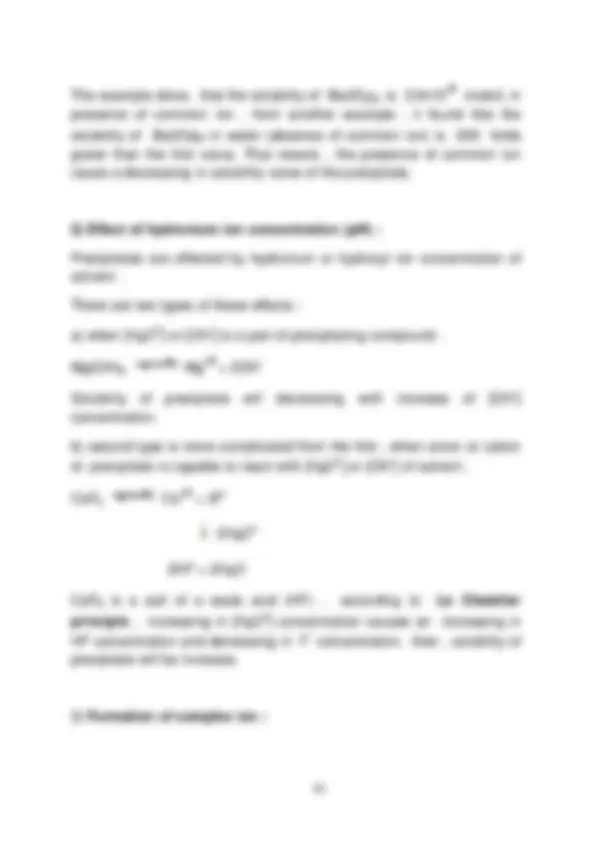
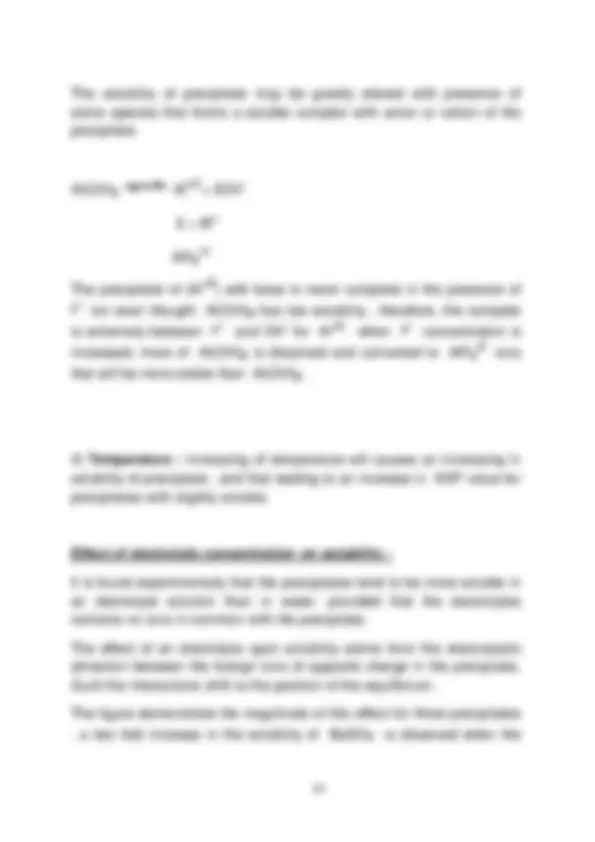
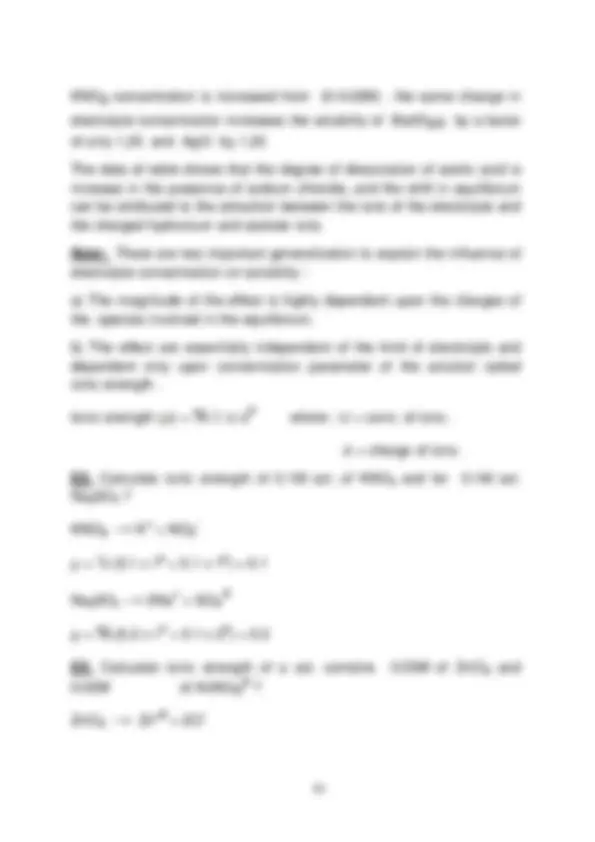
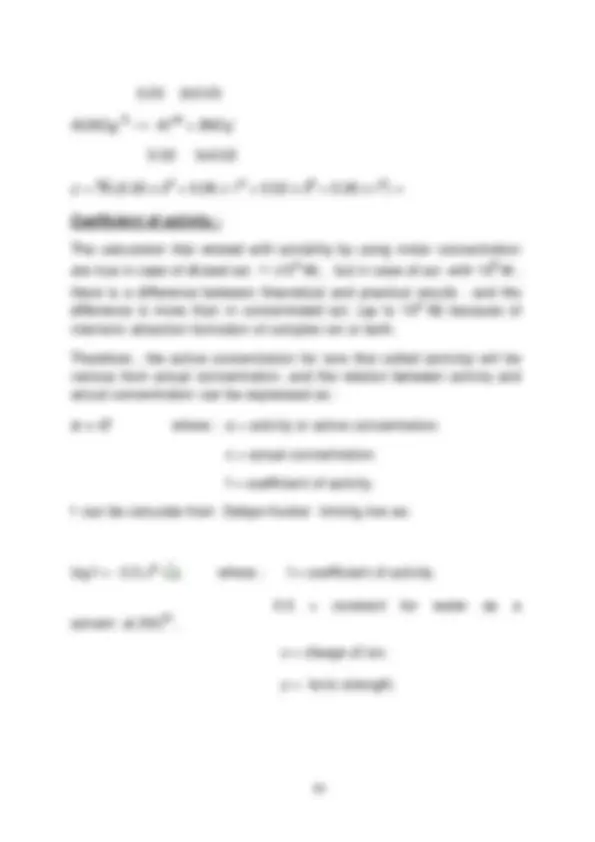
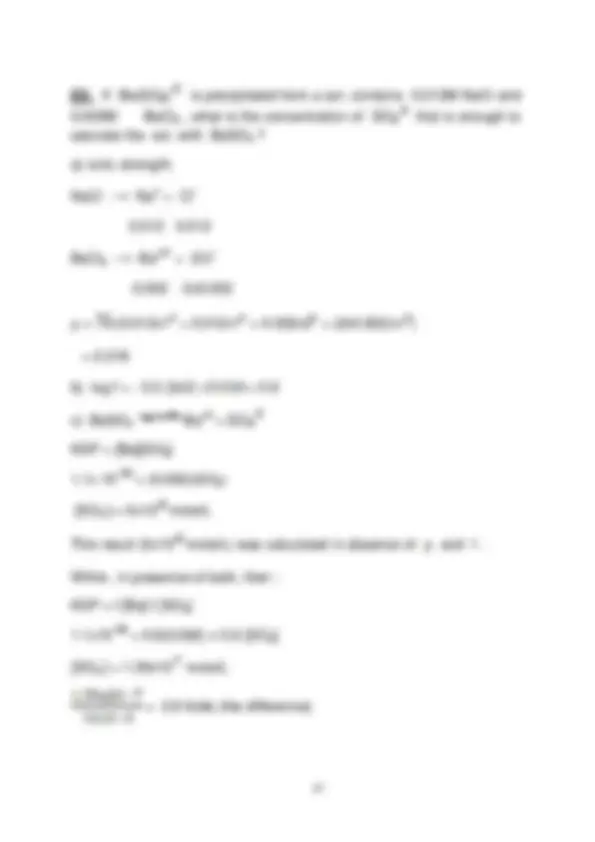


Study with the several resources on Docsity

Earn points by helping other students or get them with a premium plan


Prepare for your exams
Study with the several resources on Docsity

Earn points to download
Earn points by helping other students or get them with a premium plan
Community
Ask the community for help and clear up your study doubts
Discover the best universities in your country according to Docsity users
Free resources
Download our free guides on studying techniques, anxiety management strategies, and thesis advice from Docsity tutors
Precipitation titration is a very important , because it is a perfect method for determine halogens and some metal ions . Titration curves for precipitation ...
Typology: Schemes and Mind Maps
1 / 27

This page cannot be seen from the preview
Don't miss anything!




















Chapter Five :
Precipitation titration :
Volumetric methods based upon the formation of slightly soluble precipitate are called " precipitation titration ".
Because of the precipitating titration based upon utilizing silver nitrate
(AgNO 3 ) as a precipitating agent, then it called " argentimetric
processes ".
Precipitation titration is a very important , because it is a perfect method for determine halogens and some metal ions.
Titration curves for precipitation titrations :
Titration curves are represents :
The change in conc. of reactants throughout titration.
Titration error that is likely occur when using the indicators.
The conditions at equivalent point.
EX. Derive a titration curve for the titration of 50ml of 0.1M NaCl with
0.1M AgNO 3 , KSP AgCl = 1.82x10 -10^?
Notes :
In precipitation titration we are using molar and formal conc. and we are not using normal conc.
Precipitation titration methods are used to determine halogin ions.
Precipitation titration curves are plotte as :
Precipitation titration curve is influenced by the conc. of Ag +^ and Cl -
Precipitation titration curve is influenced by KSP value (completeness of reaction). when KSP value is small the titration curve is perfect.
Ansewer of example :
a) before adding AgNO 3 :
pCl = - log [Cl - ] = - log 0.1 = 1
pAg = zero
b) after adding 10ml of AgNO3 :
(50x0.1) (10x0.1) 0 5 1 0
4 0 1
[Cl - ] = = 6.7x10 -
pCl = - log 6.7x10 -2^ = 1.
[Ag + ] = = = 2.7x10 -
pAg = - log 2.7x10 -9^ = 8.
e) after adding 52.5ml of AgNO 3 :
(50x0.1) (52.5x0.1) 0
5 5.25 0
0 0.25 0.
[Ag + ] = = 2.4x10 -
[Cl - ] = =
pAg = 2.
pCl = 7.
End point detection precipitation titration :
1) formation of a second colored precipitate (Mohr method):
This method depends on formation of second highly colored precipitate for detect end point.
This method has been widely applied to the titration of chloride ion and
bromide ion with silver nitrate , and the indicator is chromate ion (CrO 4 -2 )
. the end point being signaled by the appearance of red silver chromate(Ag 2 CrO 4 ).
KSP (AgCl) = 1.35 x 10 -5^ (from previous example)
KSP(Ag 2 CrO 4 ) = 1.2 x 10 -
KSP = [Ag + ]^2 [CrO 4 -2 ]
[CrO 4 -2 ] = =
[CrO 4 -2 ] = 6x10 -3 M
The titration is performed in neutral or slightly basic medium pH = (7-10)
2CrO 4 -2^ + 2H +^ 2HCrO 4 -2^ Cr 2 O 7 -2^ + H 2 O
2Ag +^ + 2OH -^ 2AgOH Ag 2 O (s) + H 2 O
The presence of an excess of either sodium hydrogen carbonate or borax in the sol. tends to maintain the hydrogen ion conc. within suitable limits.
2) formation of colored complex ( Volhard method ) :
Volhard method can be use as a directly method to detect Ag +^ and an indirectly method to detect halides.
To detect silver ion : a standard sol. of thiocyanate is use as a titrant for silver ion. Iron ion (III) is use as an indicator imparting a red coloration to sol. with first slightly excess of thiocyanate.
Ag +^ + SCN -^ AgSCN (s)
Fe +3^ + SCN -^ Fe (SCN) +
The titration must be done in acidic medium to prevent the precipitate of Iron(III) as hydrated oxide (iron hydroxide). also , most of ions in neutral
or weak acid medium are gives a precipitate with Ag +^. It found from the
experimental , that the red Fe (SCN) +2^ complex color can detect at 6.
x 10 -6 M.
Chelates : are produced when a metal ion coordinates with two or more donor groups of a single ligand , and forming a cyclic structure.
Chelates can be classified into :
a) Chelating agent (ligand) whose share only one electron pair is
called " mono dentate "
b) ligand whose share two electron pairs is called " Bidentate "
c) ligand whose share three electron pairs is called " Tridentate " , and four is called " Tetradentate " , " pentadentate " , " Hexadentate ".. ect.
Titration curve for complexation titration :
When a metal ion M with a coordination number of four is react with tetradentate ligand D :
M + D MD
K f = K f = formation constant
Similarly , the equilibrium between M and bidentate ligand B is :
M + 2B MB 2
This equation can be write as :
M + B MB ………… K f1 = = 10^12
MB + B MB 2 ………. K f2 = = 10^8
From the curve , the ligand that combines with a metal ion in 1:1 ratio is better from others , because the change in pM value at equivalent point region is largest. that means , combine in lower ratios with metal ions are ordinarily superior reagents for complex formation titration.
Composition of EDTA solution as a function of pH :
The most commonly chelon (or titrant) used in complexation titration is
EDTA (ethylenediamintetraaceticacid).
EDTA is a weak acid dissociate in four steps :
H 4 y + H 2 O H 3 y -^ + H 3 O +
H 3 y -^ + H 3 O +^ H 2 y -2^ + H 3 O +
H 2 y -2^ + H 3 O +^ Hy -3^ + H 3 O +
Hy -3^ + H 3 O +^ y -4^ + H 3 O +
These values refers to that the first two protons are lost much more readily than the remaining two.
C T = [H 4 y] + [H 3 y - ] + [H 2 y -2 ] + [Hy -3 ] + [y -4 ]
It found that EDTA values depends upon pH of solution , where is :
a) when pH (3 - 6) , H 2 y -2^ is predominate.
b) when pH (6 -10) , Hy -3^ is predominate.
Complexes of EDTA and metal ions :
EDTA as a titrant is combines with metal ion in 1:1 ratio regardless of the charge of the cation. These reaction can be express by :
M +2^ + H 2 y -2^ My -2^ + 2H +
M +3^ + H 2 y -2^ My -1^ + 2H +
M +4^ + H 2 y -2^ My + 2H +
M +n^ + y -4^ My (n-4)+
K My =
EDTA forms chelates with all cations in 1:1 ratio and these chelates are very stable. this great stability is come from the several complexing sites within the molecule.
Formation constant for EDTA complexes :
Cation K My log K My
Ag +^ 2.1x10^7 7.
Mg +2^ 4.9x10^8 8.
Ca +2^ 5x10^10 10.
Fe +2^ 2.1x10^14 14.
Sr +2^ 4.3x10^8 8.
Ag +^ + y -4^ [Ag y -3 ]
K My =
2.1x10^7 =
K (^) My = K My x
K (^) My =
Derivation of titration curves for EDTA titration :
Derive the titration curve for 50ml of 0.01F Ca +2^ with 0.01F of EDTA in
a solution has pH = 10?
a) K (^) Cay = K (^) Cay x
K (^) Cay = 5x10^10 (from tables)
K (^) Cay = 5x10^10 x 3.5 x10 -
b) calculation of pCa befor end point :
Ca +2^ + y -4^ Cay -
(50x0.01) (25x0.01) 0
0.5 0.25 0
0.25 0 0.
d) when adding 60ml of EDTA :
Ca +2^ + y -4^ Cay -
(50x0.01) (60x0.01) 0
0.5 0.6 0.
0 0.1 0.
[Cay -2 ] = = 4.5x10 -
[C T ] = = 9.1x10 -
K (^) My =
1.75x10^10 =
[Cay -2 ]= x
pCa = -log x
Indicators for EDTA titration :
Many indicators are used for metal ion titration with EDTA.
These indicators are organic dyes which form colored chelates with metal ions in range that is unique to the cation and dye.
The colored complexes being visible to eye in range of 10 -6 M to 10 -7 M.
Erochrome black T (EBT) , is one of the best indicators use in EDTA titration , it contain an aromatic azo dye. its structure as follow :
From the structure , the proton associated with sulphonic acid group is completely dissociated in an aqueous medium ,and , the phenolic protons are only partially dissociated :
H 3 In + H 2 O H 2 In -^ + H 3 O +
H 2 In -^ + H 2 O HIn -2^ + H 3 O +
HIn -2^ + H 2 O In -3^ + H 3 O +
EBT behaves also an acid-base indicator , because that the acids and there conjugate bases are differ in color.
Method complexes of EBT are red , then to indicate the color change with EBT the pH must be 7 or more ,so that the blue form of the
Predominates in the absence of metal ion.
The end point reaction is then :
MIn -^ + Hy -3^ HIn -2^ + My -
red blue
Titration method employing EDTA :
Direct titration method are limited to metal ions that react rapidly with EDTA and that can be detect the end point of these reactions.
If direct method is fail , the analysis can be done by back-titration or displacement titration.
Solubility of precipitates
Solubility of precipitate is defined as disappeare of atoms or molecules or ions of solute through atoms or molecules of solvent. Or it refers to the amount of solute capable to dissolve in a volume of solvent. Therefore , the chemical substances can be classified depends upon its solubility to : soluble , or partially soluble , or insoluble.
Solubility of inorganic compounds in water :
a) all ammonium , sodium , potassium salts are soluble in water.
b) all nitrates , acetates are soluble in water.
c) all chlorides are soluble in water except chlorides of silver , mercury and lead.
d) all sulphate are soluble in water except sulphate of barium and lead , while sulphate of calcium and strontium are moderately soluble.
e) all hydroxides are insoluble in water except hydroxide of ammonium , sodium and potassium.
Solubility product constant (K.S.P) :
K.S.P is an important constant which is applied to saturated solution of slightly soluble but completely ionized such as salts or metal hydroxide.
It is calculate from multiplying of anion and cation concentrations :
AB A +^ + B -
K.S.P = [ A + ] [ B -^ ]
Am Bn mA +n^ + nB -m
K.S.P = [ A +n ] m^ [ B -m^ ] n
EX. Calculate no. of grams of Ba(IO 3 ) 2 can be dissolved in 150ml of
water in 25C O^ , K.S.P = 1.75x10 -9^?
Ba(IO 3 ) 2 Ba +2^ + 2IO 3 -
x 2x
K.S.P = [ Ba + ] [ IO 3 -^ ]^2
1.57x10 -9^ = (x)(2x)^2
1.57x10 -9 = 4x^3
X = 7.3x10 -4^ mole/L
mg of Ba(IO 3 )^2 = solubility x M.wt x volume
= 7.3x10 -4^ x 487 x L
= 0.0533 gm x 1000 = 53.3 mg
We can express salts by :
a) AB : the ratio of cation to anion is 1:1 , like: Ag + Cl -^ , Pb + S -
AgCl Ag +^ + Cl -
x x
K.S.P = (x)(x) = x^2
X =
b) AB 2 or A 2 B : the ratio is 1:2 or 2:1, like: PbI 2 , HBr 2 , Ag 2 CrO 4
PCl 5 P +^ + 5Cl -
x 5x
K.S.P = (x)(5x)^5 = 3125 x^6
EX. Calculate the solubility in mole/L for AgCl , KSP= 1.8X10 -10^?
AgCl (s) Ag +^ + Cl -
KSP = [Ag + ][Cl -^ ]
1.8x10 -10^ = (x)(x)
1.8x10 -10^ = x^2
x = =
EX. The solubility of BaSO 4 is equal to 1.14x10 -5^ M , calculate KSP?
KSP = [Ba +2 ][SO 4 -^ ]
KSP = [1.4X10 -5 ] [1.4X10 -5 ]
KSP = 1.3x10 -
EX. Calculate the solubility in mole/ L for Ag 2 CrO 4 , KSP = 1.1x10 -12^?
Ag 2 CrO 4 2Ag +^ + CrO 4 -
KSP = (2x)^2 (x)= 4x^3
Application of KSP in precipitation :
Q: How can you predict weather a precipitate is formed or doesn't formed when a solution of positive ion is mixed with other solution of negative ion?
The predict that a precipitate formed or not is depends upon the value of KSP and IP.
In a solution contain Ag +^ ion and Cl -^ ion , therefore :
IP = [Ag + ][Cl -^ ]
unsaturated with AgCl.
If IP = KSP the solution is super saturated and ppt. take place
(or form).
EX. 10ml of 10 -5 M AgNO 3 solution mixed with 10ml of 10 -5 M HCl solution is the ppt. formed , KSP =
.اﻟﺤﺠﻢ وﯾﺰداد اﻟﺘﺮﻛﯿﺰ ﯾﻘﻞ اﻟﺘﺨﻔﯿﻒ وﻋﻨﺪ‘ اﻟﻤﺤﻠﻮل ﯾﺘﺨﻔﻒ ﺳﻮف ﻓﺎﻧﮫ اﻟﻤﺤﻠﻮﻟﯿﻦ ﻣﺰج ﺣﺎﻟﺔ ﻓﻲ
[ Ag + ] = 10 -5 /
[ Cl -^ ] = 10 -5 /
IP = 10 -5 /2 x 10 -5 /2 =
When it is a precipitate in the solution , then it is heterogeneous system and the solution is saturated.
Q: How we can dissolve more than of precipitate?